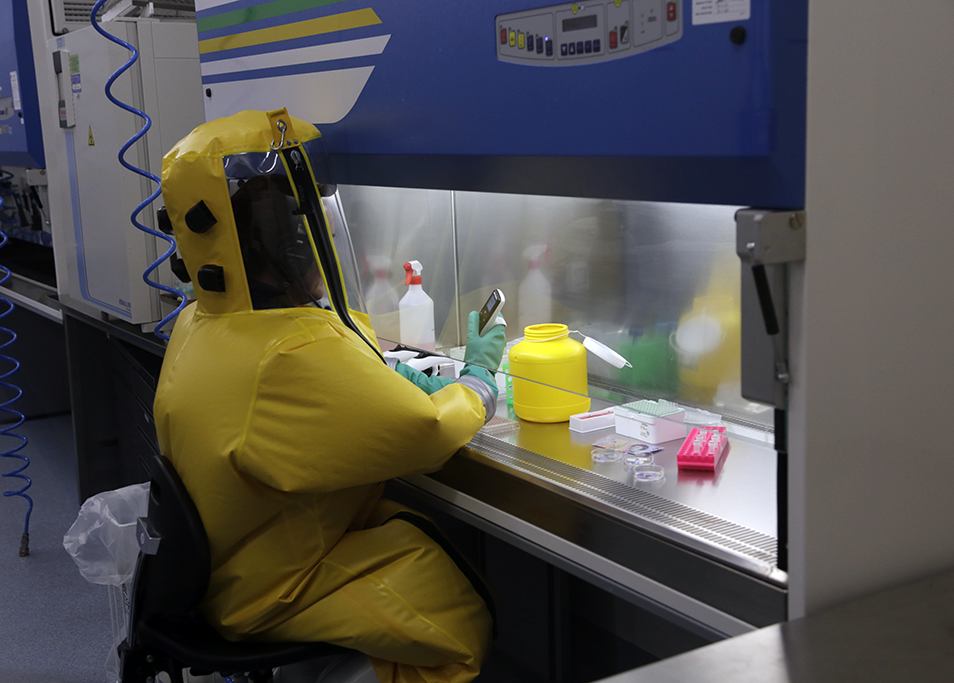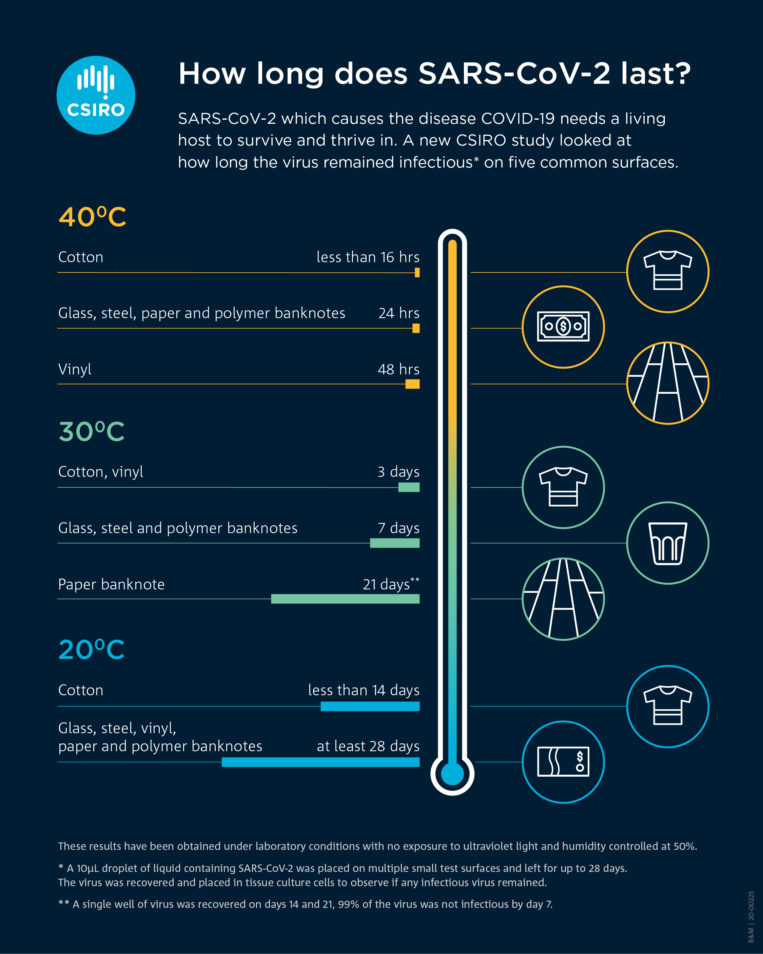
Exploring COVID-19 and surfaces at our highly secure Biosecurity Level 4 laboratories at the Australian Centre for Disease Preparedness. Here a researcher is applying droplets of the SARS-CoV-2 virus to test surfaces.
As the world continues to react and adjust to life during a pandemic, we are working toward a better understanding of how SARS-CoV-2 behaves. This virus is responsible for the COVID-19 disease.
A new study by our researchers looks at the effect of temperature on the virus. And how long the virus remains infectious (survives) on five common surfaces. We tested these surfaces:
- Paper and polymer banknotes
- Stainless steel
- Glass
- Vinyl
- Cotton.
SARS-CoV-2 has been shown to be readily transmissible directly between people. However, high contact surfaces including bank ATMs, handrails, door handles, elevator buttons and supermarket self-serve kiosks potentially contaminated with SARS -CoV-2 may also be a source of infection.
So, how do COVID-19 and surfaces interact? The results from this study demonstrate SARS-CoV-2 can remain infectious on surfaces for long periods of time. It also shows that cooler temperatures extend survival time.

This infographic presents the results of our study on COVID-19 and surfaces. The investigation revealed how long SARS-CoV-2 survives on five different surfaces at three temperatures, 200C, 300C and 400C.
While cleaning of frequently touched surfaces has increased, our findings reinforce the importance of cleaning your hands. Wash your hands with soap and water for at least 20 seconds or use an alcohol-based hand rub containing at least 70 per cent alcohol. It’s important to avoid touching your mouth, nose and eyes where possible.
So, how much do you think you know about COVID-19 and surfaces?
Take the COVID-19 and surfaces quiz:
Results
#1. Which virus causes the COVID-19 disease?
ANSWER: Severe Acute Respiratory Syndrome Coronavirus 2 (SARS-CoV-2). Learn more about this virus: https://blog.csiro.au/coronavirus-characteristics/
#2. How long can the virus survive on stainless steel at 20 degrees Celsius?
ANSWER: 28 days. Viruses are inactivated naturally over time, at different rates, depending on the makeup of a particular virus, the surface they are on, the liquid they are in and other environmental factors like temperature and humidity. Of course, the more virus you put on at the start, the longer it takes before you can no longer detect the virus. We started with the sort of amounts you would find in saliva and mucus from the noses of infected people and monitored the rate of inactivation. We don’t know how much virus it takes to infect someone, but we were still able to recover infectious virus after 28 days on stainless steel.
#3. Does the virus survive longer in cooler or warmer temperatures?
Answer: Cool. We monitored the rate of inactivation on different surfaces at different temperatures. For all the surfaces we tested, the cooler the temperature, the longer the virus survived.
#4. Which one of the following is a porous (rough) surface?
ANSWER: Cotton cloth. Cotton cloth is a porous or rough surface. We found that, on the cotton material we used, the virus was rapidly adsorbed and “clung” to the fabric, so there was an immediate reduction in the amount of virus we could recover from the material.
#5. SARS CoV-2 replicates by inserting its RNA into a human cell's own replication machinery. What does RNA stand for?
ANSWER: Ribonucleic acid (RNA). RNA is found in nature as a single strand folded onto itself, rather than a paired double strand like DNA.
#6. Our Australian Centre for Disease Preparedness (ACDP) is closest to which capital city?
ANSWER: Our ACDP is located in Geelong, Victoria. It is closest to Melbourne.
#7. What is a fomite?
ANSWER: A surface or object that may be contaminated by an infectious agent and lead to infection.
#8. What is thought to be the main way the virus is spread between people?
ANSWER: The virus is spread by aerosol and respiratory droplets.
#9. The virus has a fatty outer layer for protection. What works to break this down?
ANSWER: Soap and water. Soap acts as a detergent which will break down the fatty layer around the SARS-CoV-2 virus particles. Read more: https://blog.csiro.au/covid19-virus-spread/
#10. In our study, how long does the virus survive on vinyl at 40C?
ANSWER: Our study recorded 48 hours.





21st October 2020 at 11:48 pm
Wow got 7?